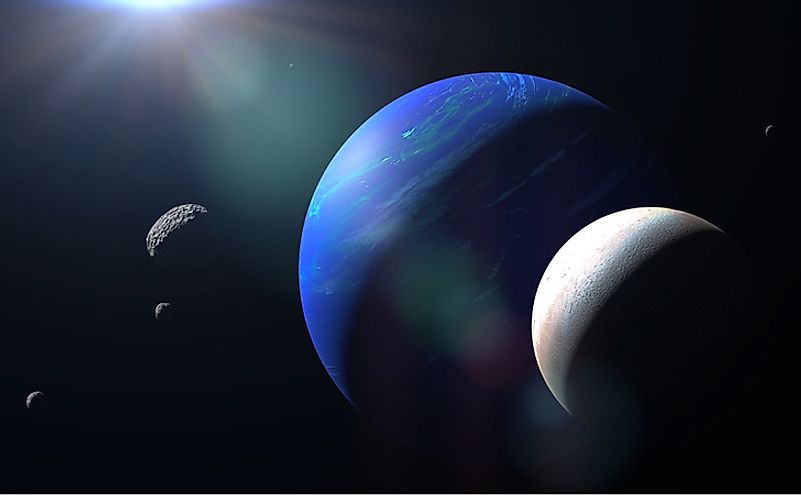10 Interesting Facts About Neptune

Neptune is named after the Roman god of the sea and is one of the fascinating planets in the Solar System. The planet was the last to be discovered as it was not visible to the naked eye. The credit for the discovery of the planet was given to Le Verrier, a French mathematician and John Adams, an English mathematician who had both predicted the existence of a “Planet X.” In 1846, the planet was found by Johann Galle, a German astronomer. The finding resulted in an international dispute with two opposing sides battling in support of Adam and Le Verrier, respectively. Finally, a decision was made that gave both mathematicians equal recognition for Neptune’s discovery.
Neptune Is The Solar System's Coldest Planet
Temperatures at the top of clouds in Neptune are estimated to be about -366 degrees Fahrenheit. An unprotected human being would probably freeze in seconds if exposed to such temperatures. Neighbouring Pluto (a dwarf planet) is much colder with temperatures of -400 degrees Fahrenheit.
Neptune’s Atmosphere Is Thick And Stormy
The atmosphere on Neptune is incredibly thick and is comprised of hydrogen (74%), helium (25%), and methane (1%). The atmosphere is also known to contain icy clouds and by far the fastest winds in the solar system blow here. Recorded wind speeds on the planet reach 1,250 miles per hour, which is comparable to the top speed of a US F/A-18 Hornet fighter jet. For comparison, the strongest winds on earth only hit at about 250 miles per hour. The planets’ deep blue color is derived from icy methane particles. Its distinct blue color also helps to distinguish it from Uranus. Hazes of smog formed by hydrocarbons are a dominant feature of the upper atmosphere. Hydrocarbon snowflakes formed in the atmosphere usually melt before they get to the planet’s surface.
Planetary Rings Of Neptune Are Difficult To See
Neptune has five rings (Adam, Galle, Arago, Lassell, and Le Verrier) that are very difficult to see compared to the bold and bright rings of Saturn. The rings are named after astronomers associated with discoveries about the planet.
Neptune Is Furthest From Sun
Neptune is the furthest planet from the sun. One could argue that this has not always been the case. After the discovery in 1846, Neptune was the furthest planet from the sun. Pluto was then discovered in 1930 and at that time, was classified as the most distant planet from the sun. Following the discovery of Pluto, the title was stripped from Neptune. Pluto’s orbit was, however, observed to be very elliptical, meaning that in some periods, Pluto’s orbit was closer to the sun than that of Neptune's. For example, during the period between 1979 and 1999, Pluto was seen to orbit closer to the sun compared to Neptune. In August 2006, the matter of distant planets was discussed at the International Astronomical Union General Assembly. The assembly was preceded by the discovery of several “Pluto-sized” planet-like bodies such as Haumea, Eris, Makemake, and Sedna in the Kuiper Belt. The discoveries led to the re-emergence of a long-held question – what is a planet? In one of the most controversial decisions in the assembly’s history, a resolution was passed, which standardized the definition of a planet. The decision led to the demotion of Pluto to a dwarf planet. Neptune thus once again acquired its title as the furthest planet from the sun.
Neptune Features In Pop Culture
Despite its distance from the earth, the planet is frequently referenced in pop culture and fiction. The planet is mentioned in science fiction films such as Event Horizon, cartoon series like Futurama, and in the “Sleep No More” episode of Dr. Who.
Neptune's Moons Are Named After Greek Gods
Neptune has 13 moons (plus an additional one awaiting confirmation) that are named after Greek sea gods and nymphs. Triton is Neptune’s largest moon. It orbits the planet in the opposite direction relative to its other moons. This observation supports a hypothesis in the scientific community that the planet’s gravitational pull probably captured Triton. Some scientists reckon that Triton is slowly spiraling towards Neptune.
You Will Sink If You Stand On Neptune
The gravitational force on Neptune is just 0.17 times stronger than the earth’s gravity. Standing on the surface of the planet without sinking is, however, not possible as it is a ball of gas and ice.
Up-close Observation Of Neptune Happened Only Once
Neptune has only been viewed up-close by a spacecraft once since its discovery. The flyby was conducted by NASA’s Voyager 2 in August 1989. The Voyager 2 passed within 1,864 miles off Neptune’s the North Pole, making it the closest approach made by Voyager 2. The flyby allowed for the study of the planet’s atmosphere, magnetosphere, rings, and moons. The Voyager 2 also obtained a view of the planet’s “Great Dark Spot” – a rotating storm system that has since disappeared.
Shorter Days And Longer Years Than Earth
A Neptunian day is typically 16 hours, and it is the duration of time it takes for the planet to complete one rotation. A Neptunian year, on the other hand, is about 165 Earth years. The long years are attributed to the longer duration of time it takes Neptune to complete one revolution around the sun.
Neptune Experiences Seasons
The planet has an axial tilt of 28.30which is close to that of the earth, which is 23.50. The seasonal changes of the planet are subtly similar to those on earth.
Visiting Neptune A Future Possibility?
Since the flyby that was conducted by Voyager 2 in 1989, the scientific community and the general public are eager to obtain additional information and dazzling images of the deep blue planet. Those charmed by the Neptune might, however, have to wait a bit longer for a possible return to the planet’s system by NASA. The possible returns are envisioned to take place in the late 2020s or early 2030s.











